Malignant mesothelioma
Jump to navigation
Jump to search
Malignant mesothelioma, also mesothelioma, is a form of cancer. It arises from the mesothelium.
| Malignant mesothelioma | |
|---|---|
| Diagnosis in short | |
 Malignant mesothelioma. H&E stain. | |
|
| |
| LM | infiltrative atypical cells (epithelioid, spindled or both) |
| Subtypes | biphasic mesothelioma, epithelioid mesothelioma, desmoplastic mesothelioma, sarcomatoid mesothelioma. |
| LM DDx | mesothelial hyperplasia, fibrosing pleuritis, adenocarcinoma - esp. lung, serous carcinoma |
| IHC | calretinin +ve, D2-40 +ve, CK5/6 +ve, WT-1 +ve, CK7 +ve, CEA -ve, TTF-1 -ve |
| Molecular | p16 deletion |
| Site | lung, peritoneum, omentum, pericardium |
|
| |
| Clinical history | asbestos exposure |
| Prevalence | rare |
| Prognosis | very poor |
It should not be confused with benign multicystic mesothelioma and benign papillary mesothelioma.
General
Locations:
- Lung.
- Primary peritoneal.
- Primary pericardial.[3]
Epidemiology:
- Strong association with asbestos exposure.
Note:
- No association with smoking.[citation needed][4]
Asbestos
Conditions associated with asbestos exposure (mnemonic PALM):[5]
- Pleural plaques.
- Asbestosis.
- Lung carcinoma.
- Malignant mesothelioma.
Possible association with asbestos exposure:
Microscopic
Features:[7]
- Infiltrative atypical cells - key feature.
- Infiltration into fat - diagnostic.
- +/-Epithelioid cells - may be cytologically bland, i.e. benign appearing.
- Variable architecture: sheets, microglandular, tubulopapillary.
- +/-Psammoma bodies.
- +/-Spindle cells.
- +/-Ferruginous body - strongly supportive.[8]
- Looks like a (twirling) baton - segemented appearance, brown colour.
- Thin (asbestos) fiber in the core.
Notes:
- Asbestos body is not strictly speaking a synonym for ferruginous body.
- Don't diagnose mesothelioma in situ.[citation needed]
DDx:[9]
- Fibrosing pleuritis - should not have nodules, more cellular on the aspect adjacent to the effusion.
- Reactive mesothelial cells - may be atypical.
- Mesothelial hyperplasia.
- Adenocarcinoma - esp. lung adenocarcinoma.
- Serous carcinoma.
Images
Subtypes
List of subtypes - mnemonic BEDS:[9][7]
- Biphasic mesothelioma.
- 10%+ of epithelioid & 10%+ sarcomatoid.
- Epithelioid mesothelioma.
- Desmoplastic mesothelioma.
- Should be 50%+ dense tissue with storiform pattern & atypical cells.
- Sarcomatoid mesothelioma.
Other:
- Small cell mesothelioma.[10]
Stains
- PASD -ve.
- Mucicarmine -ve.
- Typically +ve in adenocarcinoma.
IHC
Mesothelioma versus mesothelial hyperplasia
Features:[11]
- EMA +ve ~100% (vs. ~10%).
- Desmin -ve ~5% (vs. ~85%).
- GLUT1 +ve ~50% (vs. ~10%)
- p53 +ve ~50% (vs. ~2%).
Note:
- The above are not very useful in individual cases.
- A simple pankeratin is useful for seening where epithelial cells are.
Mesothelioma versus adenocarcinoma
- Several panel exists - no agreed upon best panel.[12]
- Usually two carcinoma markers + two mesothelial markers.
Panel:[12]
- Mesothelial markers:
- Calretinin.
- WT-1.
- D2-40.
- CK5/6.
- Carcinoma markers:
- CEA (monoclonal and polyclonal).
- TTF-1.
- Ber-EP4.
- MOC-31.
- CD15.
Other carcinoma markers:
Molecular
Notes:
- p16 IHC does not give the same result.
- Sensitivity of p16 deletion is low.
See also
References
- ↑ Haber, SE.; Haber, JM. (2011). "Malignant mesothelioma: a clinical study of 238 cases.". Ind Health 49 (2): 166-72. PMID 21173534.
- ↑ Mineo, TC.; Ambrogi, V. (Dec 2012). "Malignant pleural mesothelioma: factors influencing the prognosis.". Oncology (Williston Park) 26 (12): 1164-75. PMID 23413596.
- ↑ Sardar, MR.; Kuntz, C.; Patel, T.; Saeed, W.; Gnall, E.; Imaizumi, S.; Lande, L. (2012). "Primary pericardial mesothelioma unique case and literature review.". Tex Heart Inst J 39 (2): 261-4. PMID 22740748.
- ↑ Offermans, NS.; Vermeulen, R.; Burdorf, A.; Goldbohm, RA.; Kauppinen, T.; Kromhout, H.; van den Brandt, PA. (Jan 2014). "Occupational asbestos exposure and risk of pleural mesothelioma, lung cancer, and laryngeal cancer in the prospective Netherlands cohort study.". J Occup Environ Med 56 (1): 6-19. doi:10.1097/JOM.0000000000000060. PMID 24351898.
- ↑ Mitchell, Richard; Kumar, Vinay; Fausto, Nelson; Abbas, Abul K.; Aster, Jon (2011). Pocket Companion to Robbins & Cotran Pathologic Basis of Disease (8th ed.). Elsevier Saunders. pp. 375. ISBN 978-1416054542.
- ↑ Reid, A.; Heyworth, J.; de Klerk, N.; Musk, AW. (Nov 2009). "Asbestos exposure and gestational trophoblastic disease: a hypothesis.". Cancer Epidemiol Biomarkers Prev 18 (11): 2895-8. doi:10.1158/1055-9965.EPI-09-0731. PMID 19900938.
- ↑ 7.0 7.1 Humphrey, Peter A; Dehner, Louis P; Pfeifer, John D (2008). The Washington Manual of Surgical Pathology (1st ed.). Lippincott Williams & Wilkins. pp. 156. ISBN 978-0781765275.
- ↑ URL: http://medical-dictionary.thefreedictionary.com/asbestos+body. Accessed on: 4 November 2011.
- ↑ 9.0 9.1 Corson, JM. (Nov 2004). "Pathology of mesothelioma.". Thorac Surg Clin 14 (4): 447-60. doi:10.1016/j.thorsurg.2004.06.007. PMID 15559051.
- ↑ Mayall, FG.; Gibbs, AR. (Jan 1992). "The histology and immunohistochemistry of small cell mesothelioma.". Histopathology 20 (1): 47-51. PMID 1310669.
- ↑ Hasteh, F.; Lin, GY.; Weidner, N.; Michael, CW. (Apr 2010). "The use of immunohistochemistry to distinguish reactive mesothelial cells from malignant mesothelioma in cytologic effusions.". Cancer Cytopathol 118 (2): 90-6. doi:10.1002/cncy.20071. PMID 20209622.
- ↑ 12.0 12.1 Marchevsky AM (March 2008). "Application of immunohistochemistry to the diagnosis of malignant mesothelioma". Arch. Pathol. Lab. Med. 132 (3): 397-401. PMID 18318582. http://journals.allenpress.com/jrnlserv/?request=get-abstract&issn=0003-9985&volume=132&page=397.
- ↑ Lee M, Alexander HR, Burke A (August 2013). "Diffuse mesothelioma of the peritoneum: a pathological study of 64 tumours treated with cytoreductive therapy". Pathology 45 (5): 464–73. doi:10.1097/PAT.0b013e3283631cce. PMID 23846294.
- ↑ Ohta Y, Sasaki Y, Saito M, et al. (October 2013). "Claudin-4 as a marker for distinguishing malignant mesothelioma from lung carcinoma and serous adenocarcinoma". Int. J. Surg. Pathol. 21 (5): 493–501. doi:10.1177/1066896913491320. PMID 23775021.
- ↑ Hwang H, Tse C, Rodriguez S, Gown A, Churg A (May 2014). "p16 FISH deletion in surface epithelial mesothelial proliferations is predictive of underlying invasive mesothelioma". Am. J. Surg. Pathol. 38 (5): 681–8. doi:10.1097/PAS.0000000000000176. PMID 24503757.